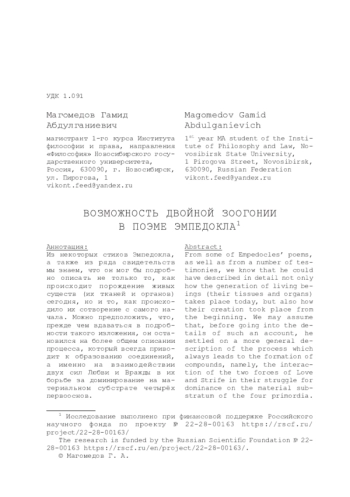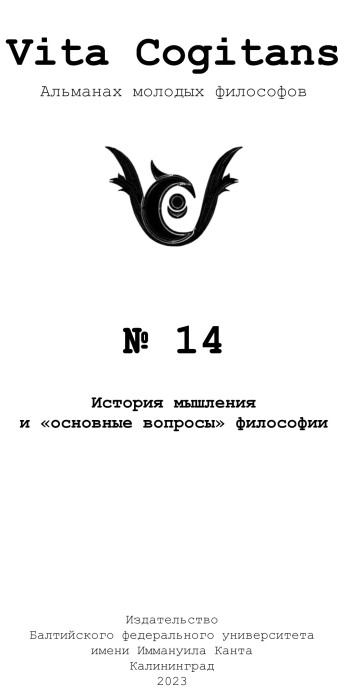Из некоторых стихов Эмпедокла, а также из ряда свидетельств мы знаем, что он мог бы подробно описать не только то, как происходит порождение живых существ (их тканей и органов) сегодня, но и то, как происходило их сотворение с самого начала. Можно предположить, что, прежде чем вдаваться в подробности такого изложения, он остановился на более общем описании процесса, который всегда приводит к образованию соединений, а именно на взаимодействии двух сил Любви и Вражды в их борьбе за доминирование на материальном субстрате четырёх первооснов. Возникает вопрос: когда в космическом цикле происходит зоогонический процесс Любви, а когда - Вражды? Действительно ли необходимо, признав существование двойной зоогонии, одновременно постулировать, что она имеет место в двух разных фазах космического цикла? Такая интерпретация предполагает реконструкцию космического цикла, состоящего из четырёх совершенно зеркальных фаз, в антиподах которых, с одной стороны, период полного господства Любви (Сфайрос), с другой - полного разделения первооснов (концентрических и однородных элементарных масс), а в промежуточных периодах - ситуация борьбы между Любовью и Враждой. В обоих промежуточных периодах есть место для формирования космоса со своей зоогонией. Нужно ли постулировать из соображений симметрии всего космического цикла существование двух космосов? Из приведённых автором соображений можно сделать вывод, что Эмпедокл действительно говорил о двойном сотворении и двойном разрушении смертных вещей. Несомненным фактом оказывается наличие определённой «производной когерентности» между первой и второй формацией, с одной стороны, и третьей, и четвёртой - с другой. Если связать эти наблюдения с интерпретацией Strasb. ст. 234-236, из которых следует, что генезис смертных вещей двоякий, то нельзя не прийти к выводу, что Эмпедокл действительно предполагал развитие двойной зоогонии. В рамках одной и той же циклической фазы происходило то порождение и разрушение Любовью, то порождение и разрушение Враждой. Остаётся только предположить, что такая двойственность всегда полностью реализуется в рамках единого космоса. Симметрия макрокосмоса состоит в следующем: с одной стороны, объединяющая сила отдельных и непохожих друг на друга частиц, с другой - зеркально противоположная сила, которая разделяет объединённые частицы и инициирует процесс ὅμοιον ὁμοίῳ. Поэтому нет необходимости для установления идеальной симметрии представлять, что при разрушении Сфайроса объединяющая сила Любви даёт форму второму космосу.
From some of Empedocles’ poems, as well as from a number of testimonies, we know that he could have described in detail not only how the generation of living beings (their tissues and organs) takes place today, but also how their creation took place from the beginning. We may assume that, before going into the details of such an account, he settled on a more general description of the process which always leads to the formation of compounds, namely, the interaction of the two forces of Love and Strife in their struggle for dominance on the material substratum of the four primordia. The question arises: when in the cosmic cycle is the zoogonic process of Love, and when - of Strife? Is it really necessary, having recognized the existence of double zoogony, to postulate at the same time that it takes place in two different phases of the cosmic cycle? Such an interpretation presupposes the reconstruction of a cosmic cycle consisting of four completely mirror phases, in the antipodes of which, on the one hand, there is a period of complete domination of Love (Sphairos), on the other hand, a period of complete separation of the primordia (concentric and homogeneous elementary masses), and in the intermediate periods, a situation of struggle between Love and Strife. In both intermediate periods there is room for the formation of the cosmos with its zoogony. Is it necessary to postulate the existence of two cosmoses for reasons of symmetry of the whole cosmic cycle? From the considerations given by the author we can conclude that Empedocles really spoke about the double creation and double destruction of mortal things. The existence of a certain «derivative coherence» between the fi and second formations on the one hand, and the third and fourth formations on the other, is an undeniable fact. If we connect these observations with the interpretation of Strasb. vv. 234-236, from which it follows that the genesis of mortal things is twofold, one cannot but conclude that Empedocles did indeed envision the development of a double zoogony. Within the same cyclic phase there was either generation and destruction by Love, or generation and destruction by Strife. It remains only to assume that such duality is always fully realized within a single cosmos. The symmetry of the macrocosm consists of the following: on the one hand, the unifying force of separate and dissimilar particles, on the other hand, the mirror-opposite force which separates the united particles and initiates the process of ὅμοιον ὁμοίῳ. It is therefore not necessary, in order to establish perfect symmetry, to imagine that at the destruction of Sphairos the unifying force of Love gives form to the second cosmos.











